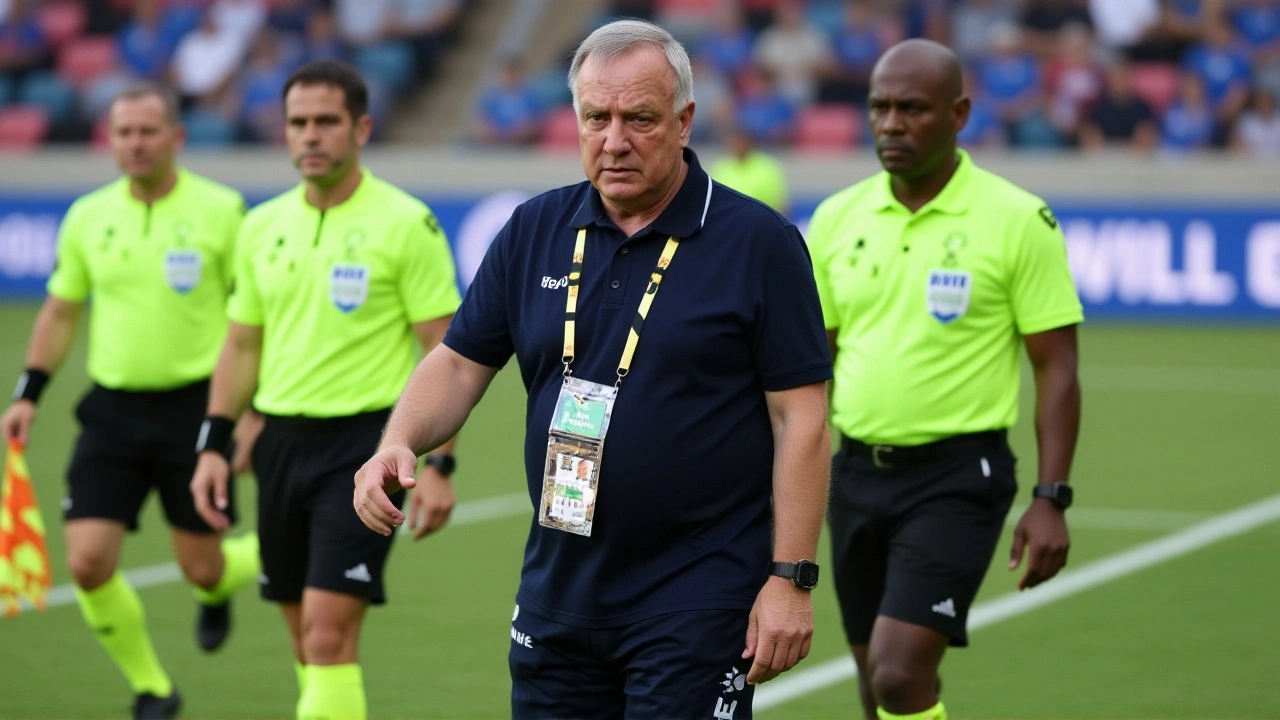When Curaçao held Trinidad and Tobago to a 1-1 draw at Estadio Ergilio Hato on October 14, 2025, it wasn’t just another draw—it was a missed opportunity that could cost them dearly in the race for the 2026 FIFA World Cup . Kenji Gorré’s 19th-minute strike had fans in Willemstad dreaming of a historic win. But Tyrese Spicer’s equalizer in the 58th minute crushed those hopes, leaving Curaçao with a frustrating, point-splitting stalemate that leaves their Group B lead hanging by a thread.
Why This Draw Feels Like a Loss
Curaçao entered the match undefeated in Group B—two wins, two draws, zero losses—topping the table with eight points and a +10 goal difference. They’d just crushed Jamaica 2-0 at home a few weeks prior, with goalkeeper Eloy Room keeping a clean sheet and Gorré again on the scoresheet. The stadium was sold out. The air was electric. Bookmakers had Curaçao as heavy favorites at -147 odds, implying a 60% chance of victory. SportsMole predicted a 2-1 win, citing the home fortress of Stadion Ergilio Hato. But football doesn’t care about predictions.Trinidad and Tobago, meanwhile, arrived with momentum after a 3-0 thrashing of Bermuda. They came to play, not just to survive. And when Spicer—just 21 years old—slipped past two defenders and fired low past Room, the stadium fell silent. Not in defeat. In disbelief. Because this was supposed to be their night. Instead, it became a cautionary tale.
The Numbers Behind the Stalemate
The final scoreline may look benign, but the underlying stats tell a different story. Curaçao had 62% possession, 14 shots (5 on target), and dominated midfield through the likes of Livano Comenencia and L. Bacuna. Trinidad and Tobago managed just 6 shots, but two were lethal. One goal, one point. That’s all they needed.Disciplinary issues plagued both sides. D. Sealy’s reckless tackle in the 33rd minute nearly cost Trinidad and Tobago a red card. L. Bacuna got into a heated exchange with an opponent in the 42nd minute, drawing a yellow. Later, N. James and J. Gaari each picked up fouls in the final 10 minutes—Gaari’s in the 89th minute, the last act of the match. These aren’t just stats; they’re signs of tension, of nerves, of pressure building.
And here’s the kicker: Curaçao has never beaten Trinidad and Tobago in World Cup qualifying. Not once. In 15 all-time meetings, they’ve won three, drawn five, lost seven. This was their sixth attempt to win at home in qualifying—and now it’s six draws. The 1980 and 2000 matches ended 0-0 and 1-1. Gorré’s goal in 2025 was the first Curaçao goal against Trinidad and Tobago in World Cup qualifying since Angelo Martina scored in 2000. For 25 years, that goal stood alone. Now it’s just another footnote.

Group B: A Tight Race With High Stakes
After five matches, the standings are razor-thin:- Curaçao: 8 points (+10 GD)
- Jamaica: 10 points (+8 GD)
- Trinidad and Tobago: 5 points (+1 GD)
- Bermuda: 0 points (-19 GD)
That’s right—Curaçao leads, but only by one point over Jamaica. And Jamaica still has a game in hand. Trinidad and Tobago, despite the draw, are still mathematically alive. Bermuda? They’re done. But the real drama is between the top three.
Curaçao’s next three fixtures are brutal: away at Jamaica, home against Bermuda, and away at Trinidad and Tobago. Win all three? They’re in. Lose one? They’re out. The pressure is no longer just on the pitch—it’s in the locker room, in the stands, in every decision made by coach René Hake.
What This Means for Caribbean Football
This isn’t just about World Cup tickets. It’s about legacy. For decades, Trinidad and Tobago were the region’s standard-bearers—2006 World Cup qualifiers, the only Caribbean team to reach the finals in the 21st century. Curaçao, once overshadowed, has risen with a new generation: Gorré, Comenencia, Room. They’re not just playing for pride—they’re playing to prove they belong.But draws like this? They’re killers. In a group where every point is gold, you can’t afford to give away chances. Curaçao had the better team, the better home advantage, the better momentum. They didn’t just fail to win—they failed to take control when it mattered most.
Trinidad and Tobago, meanwhile, showed resilience. They didn’t dominate, but they didn’t fold. Spicer’s goal was clinical. Their defense held firm under pressure. If they can replicate this in their remaining games—especially the away fixture in Curaçao next year—they could still sneak into the final CONCACAF playoff spot.

What’s Next?
The next window for World Cup qualifying arrives in March 2026. Curaçao travels to Jamaica on March 20—likely their most critical match yet. A loss there could end their dreams. A win? It rewrites the narrative. Trinidad and Tobago host Bermuda on March 24, a must-win if they’re to stay in the hunt.And then, on June 5, 2026, the two meet again—in Port of Spain. That match might decide who advances. Right now, it feels like a coin toss.
Frequently Asked Questions
Why didn’t Curaçao win despite dominating possession?
Curaçao controlled the ball and created chances, but their finishing was inconsistent—five shots on target only yielded one goal. Trinidad and Tobago defended deep, absorbed pressure, and struck with precision. Spicer’s goal came from a counterattack after a turnover, exposing Curaçao’s vulnerability when pushing forward. In high-stakes games, efficiency beats volume.
Has Curaçao ever qualified for the World Cup before?
No. Curaçao has never qualified for a World Cup finals tournament. Their best run came in 2018 qualifying, when they reached the CONCACAF Hexagonal but finished last. This 2026 campaign is their strongest yet, with a +10 goal difference and a top-three finish in Group B. A win against Jamaica in March could finally put them in contention for a playoff spot.
How significant is Estadio Ergilio Hato as a home advantage?
Extremely. The stadium in Willemstad, with its steep stands and tropical heat, creates an intimidating atmosphere for visiting teams. Curaçao has won all three of their home matches in this qualifying cycle, outscoring opponents 7-1. The sold-out crowd on October 14 was the largest in the stadium’s history for a World Cup qualifier, and the noise levels reportedly disrupted Trinidad and Tobago’s buildup play—yet they still found a way to score.
What’s the historical rivalry between Curaçao and Trinidad and Tobago?
Trinidad and Tobago hold the edge in head-to-head history: 7 wins to Curaçao’s 3, with 5 draws in 15 meetings. But Curaçao’s recent rise has narrowed the gap. Before Gorré’s goal in 2025, their only World Cup qualifying goal against Trinidad and Tobago came in 2000. The 1-1 draw in 2025 broke a streak of three straight home draws, but still extended their winless record in qualifying against them to six matches.
Who are the key players to watch in the remaining qualifiers?
For Curaçao, Kenji Gorré (4 goals this cycle) and goalkeeper Eloy Room (11 saves in 5 games) are indispensable. Livano Comenencia’s midfield control is the engine. For Trinidad and Tobago, Tyrese Spicer (3 goals in 5 games) is their breakout star, while veteran defender Kevon Carter anchors the backline. Jamaica’s Aljame Zuill and Bermuda’s Keshi Anderson are also critical to the group’s final outcome.
What does a draw like this mean for CONCACAF’s World Cup qualification structure?
It highlights the increasing competitiveness of the region. With 6.5 slots up for grabs, every point matters. Teams like Curaçao and Trinidad and Tobago—once considered underdogs—are now genuine contenders. This draw proves that even the smallest islands can compete at the highest level, making the path to the World Cup more unpredictable than ever. The days of automatic qualification for traditional powers are over.


